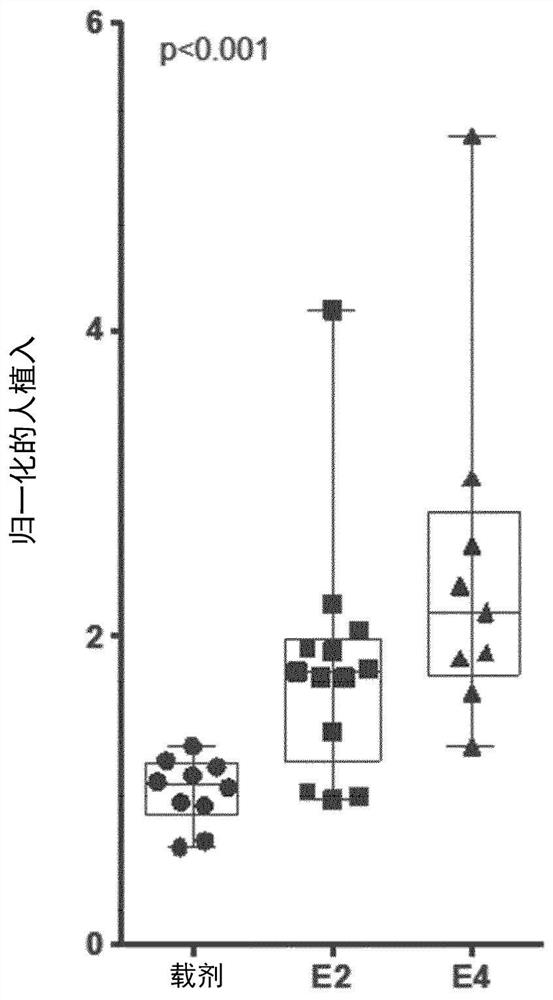Improvements for performing and facilitating the recovery after hematopoietic stem cell transplantation
A technology of hematopoietic stem cells and hematopoietic progenitor cells is applied in the field of promoting hematopoietic recovery after hematopoietic stem cell transplantation, which can solve the problems of unclear comprehensive effects of different estrogens and their underlying mechanisms.
- Summary
- Abstract
- Description
- Claims
- Application Information
AI Technical Summary
Problems solved by technology
Method used
Image
Examples
Embodiment 1
[0067] Example 1. Increased hematopoietic reconstitution following hematopoietic stem cell transplantation
[0068] Male immunodeficient NSG mice received 2.2Gy irradiation and transplanted 5×10 4 Personal cord blood CD34 + cell. Seventy-two hours later, transplanted animals received 2 [mu]g of estrogen or vehicle (olive oil) per day for 4 days. After 3-4 months, the animals were sacrificed, and the human blood engraftment (graft survival rate) was analyzed by FACS. Human hematopoietic cell populations were identified as hCD45-APC-Cy7 (Biolegend) positive and mouse CD45.1-PE (Biolegend) negative cells.
[0069] Comparisons were made to estrogen-treated or vehicle-treated animals. The results are shown in Table 1:
[0070] Table 1. Human Hematopoietic Reconstitution Percentage (Mean + / - Standard Error of Mean and Number of Mice)
[0071] carrier 26.70+ / -4.19(n=10) E2 46.05+ / -5.98(n=13) E4 47.47+ / -6.08(n=9)
[0072] In addition, human multi-line...
Embodiment 2
[0076] Example 2. Estrogen Enhances Hematopoietic Stem Cell Fraction in Human Hematopoietic Implantation
[0077] To further investigate the role of estrogen in HSCT, FACS analysis of hematopoietic progenitor (hCD34+) and hematopoietic stem cells (hCD34+ / hCD38-) within the human cell population in treated NSG as described in Example 1 was performed. The results are shown in Table 3.
[0078] Table 3. Percentage in human hematopoietic cell population (mean + / - standard error of mean and number of mice)
[0079]
[0080]
[0081] Furthermore, to study long-term effects in HSCT, human CD45+ cells were sorted and transplanted into secondary irradiated female NSG mice. Three months after the second transplantation, artificial hematopoietic engraftment was detected in all animals transplanted with cells from estrogen-treated primary mice.
[0082] Thus, estrogen treatment resulted in a 70% increase in hematopoietic progenitor cells and a doubling of HSCs. More importantly...
Embodiment 3
[0083] Example 3. Estrogen Boosts Limited Dose CD34 in Male Animals + Cell-derived artificial hematopoiesis
[0084] To determine whether estrogen could improve hematopoietic reconstitution in a small number of hematopoietic progenitor cells, male NSGs were irradiated and transplanted with low-dose human cord blood CD34+ (5×10 3 hCD34+). Human implants were analyzed as described in Example 1. The effect of estrogen on promoting the engraftment of low-dose human progenitor cells is shown in Table 4:
[0085] Table 4. Human blood reconstitution percentage (mean + / - standard error of mean and number of mice)
[0086]
[0087] Considering that human hematopoietic cells do not exceed 0.1% in the bone marrow of non-engrafted animals, estrogens (mainly E4) are favorable for achieving successful HSCT with limited doses of HPC. As previously shown, about a quarter of mice had human engraftment rates higher than 0.1%. However, E2 or E4 treatment almost tripled the proportion o...
PUM
 Login to view more
Login to view more Abstract
Description
Claims
Application Information
 Login to view more
Login to view more - R&D Engineer
- R&D Manager
- IP Professional
- Industry Leading Data Capabilities
- Powerful AI technology
- Patent DNA Extraction
Browse by: Latest US Patents, China's latest patents, Technical Efficacy Thesaurus, Application Domain, Technology Topic.
© 2024 PatSnap. All rights reserved.Legal|Privacy policy|Modern Slavery Act Transparency Statement|Sitemap



